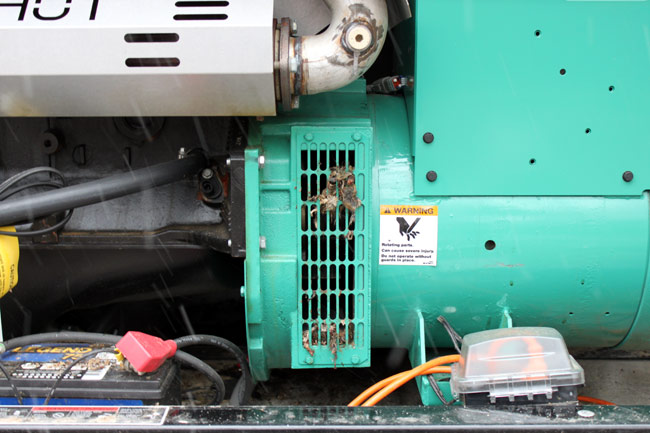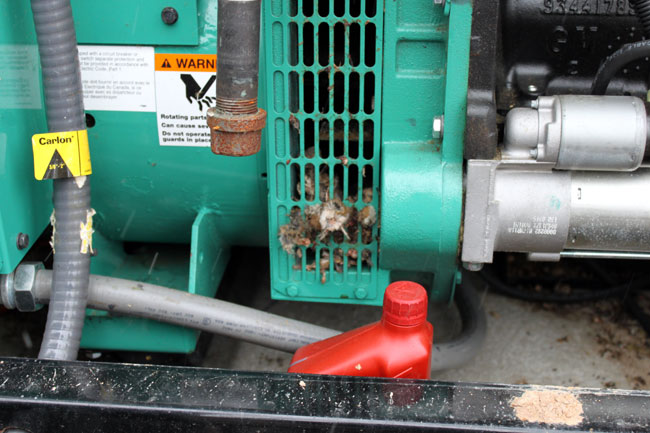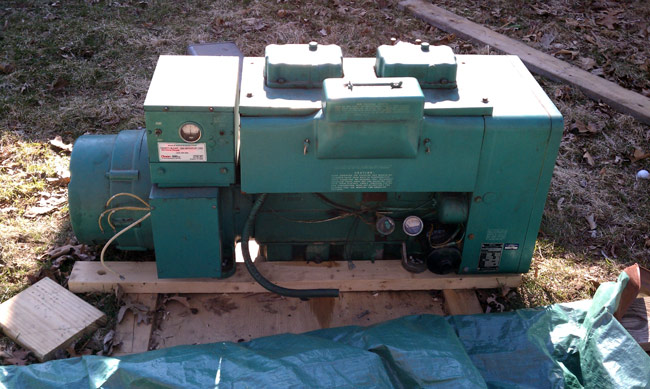Never a good mix, unfortunately, it usually turns out bad for the mice and sometimes the equipment. This is an Onan GGMA 20 KW propane generator installed in a rural area, not that the location matters that much. Mice will find what they perceive as a safe secure spot to hold up for the winter.

Unfortunately, the mice decided that the generator cooling fan was a good place to make a nest. It probably was until the generator started, then the mice had a quick lesson in centripetal force.

This will require some additional maintenance in the springtime when I change to oil. By that time, the carcasses should be mostly dried out and easier to deal with.

The mice are generally a nuisance, getting into ATU’s, transmitters, electrical panels, spare parts boxes, etc. Once in place, they begin to breed and reproduce. The gestational period for a mouse is 21 days, which means populations rapidly increase creating further problems. If left alone, mice will chew through electrical insulation, control wires, cardboard boxes, packing material, and so on. They tend to carry diseases like hantavirus and bubonic plague.
I don’t usually agree to using poison to get rid of pests, it tends to linger in the environment and accumulate up the food chain. However, judicious use of some type of poison is usually the only way to effectively get rid of a mouse infestation.
Wherever possible, make sure that all openings and holes into equipment and buildings are sealed up. Do not kill snakes and other predators, who will assist in keeping the mice in check. Employ traps and wear gloves when removing dead mice and mouse parts. Beware of fleas.






Man …..you get all the good jobs !
Oh, yes, I am so looking forward cleaning day
I’d let that Mike Rowe guy take care of that mess,…the “dirtiest jobs” guy!
A mouse put a UHF TV transmitter off the air at a place I worked at back in the 80’s. Beam power supplies sat outside the XMTR building on a pad. HVDC wire running through 3 inch conduit was some really flexible stuff built like coaxial cable. Mice entered the conduit at the open end where it attached to the XMTR cabinetry. Over time, they chewed through the HVDC wire about 2 feet into the conduit, eventually causing a big flash when the insulation was sufficiently gnawed away.
Is it still acceptable to put a few moth balls into ATU cabinets, etc? Years ago, I read that the odor would repel pests (as well as moths). Reading the hazmat label on a box of moth balls is scary. The warnings against exposure to humans would suggest you don’t want to use this method where people are involved.
@Dale, I have used moth balls to keep mice out of our summer cottage in Canada, but not in radio station ATUs. I’d imagine they would work the same. We had mice in the ATU buildings at WPTR, they got into the center of one of the air core inductor for the reference tower. I almost felt sorry for the little things, up until I had to clean up the mess.
I used poison once – never again. The family crawled behind the kitchen cabinets and expired. had to rip up the entire kitchen to get them out (while wearing breathing gear – oh, the stench).
Be DAMN careful when working around such generators!
Part of the problem is the block heater. It makes the genset a very hospitable place for mice. And that, in turn, makes for a very hospitable place for SNAKES. I’ve encountered blacksnakes (no danger, but a problem due to their excrement) and even a copperhead (BIG immediate problem if you happen to reach into the genset cabinet before he “vacates”). (And whatever you do don’t kill the damn things. The State values their lives more than yours!)
In addition to the mouse carcasses themselves getting stuck in that screening there’s the nesting materials. First encounter with such was in a 40-kW version of a similar Onan genset. In addition to a number of mice bodies being stuck in the screening on both sides of the alternator cooling fan they were both clogged with remnants of nesting materials. And, as a “bonus” when I removed the screening to clean out the detritus there appeared to be a heavy cable sticking back into that space from in front of the fan. That turned out to be a well cooked snake carcass, most of which is still in the genset. The unit would have to be dismantled to remove the remainder . . .